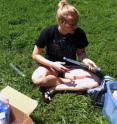Urban grass might be greener, but that doesn't mean it's 'greener'
Related images
(click to enlarge)
New research from the University of Cincinnati shows how some things you do to make your lawn green might not be conducive to "going green." Amy Townsend-Small, a UC assistant professor of geology and geography, will present her research, "Carbon Sequestration and Greenhouse Gas Emissions in Urban Ecosystems," at the Association of American Geographers annual meeting to be held April 9-13 in Los Angeles. The interdisciplinary forum is attended by more than 7,000 scientists from around the world and features an array of geography-related presentations, workshops and field trips.
At the meeting, Townsend-Small will discuss the effects lawn-management techniques have on greenhouse gas production in urban landscapes. She says there's a high energy cost associated with common lawn-care methods such as mowing, irrigation and fertilization due to the processing and transport required for these products and services.
"Landscaping is something everyone can understand," Townsend-Small says. "You probably have your own maintenance routine you do. To make your lawn look nice, you need to use fossil fuels, which emit carbon dioxide. Depending on the management intensity, lawns could either be a small sink -- meaning they store carbon -- or a small source of greenhouse gases to the atmosphere."
Fossil fuels are used to power lawn mowers and trimmers, to pump irrigation water, and to make fertilizers -- and all of these activities emit carbon dioxide.
For her research, Townsend-Small monitored the carbon uptake and storage -- known as carbon sequestration -- in the soil of urban lawns in Los Angeles and Cincinnati. Despite the extreme climate variation between the two regions, she found the lawns had surprisingly similar abilities to absorb carbon and store it in soils. But there's a stark contrast in how those lawns are managed, leading to differences in their ecological impact.
Townsend-Small found that while having a well-cared-for lawn will improve its carbon-quelling capacity, intensive lawn care isn't worth the atmospheric side effects. For example, in California's arid environment, the management required and fossil fuel energy expended to keep lawns looking lush consumes so much energy that it counteracts the soil's natural carbon sequestration abilities. But if you head nearly 2,500 miles east to Cincinnati, rainfall is more plentiful. This means more lawns don't require irrigation, helping reduce the carbon cost of lawn maintenance and preserve the carbon sequestration benefits.
This study is the first of its kind to compare the environmental cost of making urban lawns rich and productive with leaving them unmanaged and undisturbed. Two undergraduate students in UC's Women In Science and Engineering program gathered hundreds of local soil samples at different sites and analyzed the emission of powerful greenhouse gases such as nitrous oxide and methane. The University of Cincinnati proved to be an ideal location for Townsend-Small's project thanks to the proximity of the managed green spaces on campus and the natural environment of nearby city parks.
"That's one thing that's special about UC. It's in the middle of the city, and it's a great research site for us because of the access to urban green spaces," Townsend-Small says. "Now we're exploring whether you can reduce the amount of energy you need to make a lawn pretty and preserve the carbon storage in soils."
Townsend-Small's research could prove useful to cities, businesses and urban universities, such as UC, that are interested in reducing their greenhouse gas emissions. Her data offer an important warning to such groups: When measuring your carbon footprint, remember to thoroughly evaluate what's underfoot.
"Urban green space usually gets a lot of credit for all the benefits to the atmosphere," Townsend-Small says. "But most people don't consider the positive influxes of carbon dioxide from lawn maintenance."
Additional contributors to Townsend-Small's research paper were professor Claudia Czimczik (University of California, Irvine) and UC undergraduate researchers Rebecca Ransohoff and Lily Soderlund.
Funding for the Ohio research was provided by Townsend-Small's start-up funding in UC's McMicken College of Arts & Sciences.
Source: University of Cincinnati
Other sources
- Urban grass might be greener, but that doesn't mean it's 'greener'from Science DailyTue, 9 Apr 2013, 17:00:55 UTC
- Urban grass might be greener, but that doesn't mean it's 'greener'from PhysorgTue, 9 Apr 2013, 15:20:16 UTC

